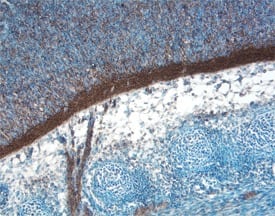Mouse Oncostatin M/OSM Antibody
R&D Systems, part of Bio-Techne | Catalog # AF-495-NA


Key Product Details
Validated by
Species Reactivity
Validated:
Cited:
Applications
Validated:
Cited:
Label
Antibody Source
Product Specifications
Immunogen
Ala24-Arg206
Accession # P53347
Specificity
Clonality
Host
Isotype
Endotoxin Level
Scientific Data Images for Mouse Oncostatin M/OSM Antibody
Oncostatin M/OSM in Mouse Embryo.
Oncostatin M/OSM was detected in immersion fixed frozen sections of mouse embryo (15 d.p.c, section through spinal cord) using Mouse Oncostatin M/OSM Antigen Affinity-purified Polyclonal Antibody (Catalog # AF-495-NA) at 15 µg/mL overnight at 4 °C. Tissue was stained using the Anti-Goat HRP-DAB Cell & Tissue Staining Kit (brown; Catalog # CTS008) and counterstained with hematoxylin (blue). View our protocol for Chromogenic IHC Staining of Frozen Tissue Sections.Oncostatin M/OSM in Mouse Embryo.
Oncostatin M/OSM was detected in immersion fixed frozen sections of mouse embryo using Mouse Oncostatin M/OSM Antigen Affinity-purified Polyclonal Antibody (Catalog # AF-495-NA) at 15 µg/mL overnight at 4 °C. Tissue was stained using the Anti-Goat HRP-DAB Cell & Tissue Staining Kit (brown; Catalog # CTS008) and counterstained with hematoxylin (blue). View our protocol for Chromogenic IHC Staining of Frozen Tissue Sections.Cell Proliferation Induced by Oncostatin M/OSM and Neutralization by Mouse Oncostatin M/OSM Antibody.
Recombinant Mouse Oncostatin M/OSM (Catalog # 495-MO) stimulates proliferation in the NIH-3T3 mouse embryonic fibroblast cell line in a dose-dependent manner (orange line). Proliferation elicited by Recombinant Mouse Oncostatin M/OSM (15 ng/mL) is neutralized (green line) by increasing concentrations of Mouse Oncostatin M/OSM Antigen Affinity-purified Polyclonal Antibody (Catalog # AF-495-NA). The ND50 is typically 0.6-3.0 µg/mL.Applications for Mouse Oncostatin M/OSM Antibody
Immunohistochemistry
Sample: Immersion fixed frozen sections of mouse embryo (E15) and thymus
Western Blot
Sample: Recombinant Mouse Oncostatin M/OSM (Catalog # 495-MO)
Neutralization
Formulation, Preparation, and Storage
Purification
Reconstitution
Formulation
Shipping
Stability & Storage
- 12 months from date of receipt, -20 to -70 °C as supplied.
- 1 month, 2 to 8 °C under sterile conditions after reconstitution.
- 6 months, -20 to -70 °C under sterile conditions after reconstitution.
Background: Oncostatin M/OSM
Oncostatin M (OSM) is a member of a cytokine subfamily that includes IL-6, IL-11, LIF, CNTF, and cardiotrophin-1. These cytokines have overlapping biological functions and shared receptor components. Mouse OSM was cloned and identified as an immediate early gene induced in various myeloid and lymphoid cell lines by a subset of cytokines including IL-2, IL-3, GM-CSF, and EPO. The mouse OSM cDNA encodes a 263 amino acid residue precursor protein that shows 48% identity with human OSM. Similar to human OSM, the C-terminal region of mouse OSM contains a highly charged region. Deletion of this C-terminal region appears to be essential for the formation of biologically active mOSM.
The biological activity of human OSM has been shown to be mediated either by the LIF/OSM receptor complex composed of gp130 and LIF R alpha or by a human OSM specific receptor composed of gp130 and OSM R alpha. It remains to be determined if the biological activities of mouse OSM can also be mediated by both receptor complexes in mouse cells.
References
- Yoshimura, A. et al. (1996) The EMBO Journal 15:1055.
- Ray, P. et al. (1996) Endocrinology 137:1151.
- Rose, T.M. and A.G. Bruce (1994) in Guidebook to Cytokines and Their Receptors, N.A. Nicola, editor, Oxford University Press, New York, p. 127.
Alternate Names
Gene Symbol
UniProt
Additional Oncostatin M/OSM Products
Product Documents for Mouse Oncostatin M/OSM Antibody
Product Specific Notices for Mouse Oncostatin M/OSM Antibody
For research use only




